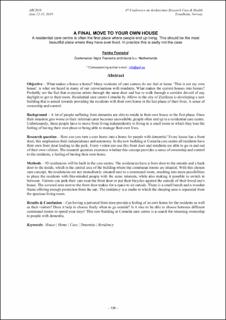| dc.contributor.author | Feenstra, Femke | |
| dc.date.accessioned | 2021-12-27T18:52:08Z | |
| dc.date.available | 2021-12-27T18:52:08Z | |
| dc.date.issued | 2021 | |
| dc.identifier.isbn | 978-82-536-1718-3 | |
| dc.identifier.issn | 2387-4295 | |
| dc.identifier.uri | https://hdl.handle.net/11250/2835490 | |
| dc.description.abstract | Objective – What makes a house a home? Many residents of care centres do not feel at home. 'This is not my own house', is what we heard in many of our conversations with residents. What makes the current houses into homes? Probably not the fact that everyone enters through the same door and has to walk through a corridor devoid of any daylight to get to their room. Residential care centre Cornelia by Allévo in the city of Zierikzee is developing a new building that is aimed towards providing the residents with their own home in the last phase of their lives. A sense of ownership and control.
Background – A lot of people suffering from dementia are able to reside in their own house in the first phase. Once their situation gets worse or their informal carer becomes unavailable, people often end up in a residential care centre. Unfortunately, these people have to move from living independently to living in a small room in which they lose the feeling of having their own place or being able to manage their own lives.
Research question – How can you turn a care home into a home for people with dementia? Every house has a front door, this emphasizes their independence and autonomy. In the new building at Cornelia care centre all residents have their own front door leading to the park. Every visitor can use this front door and residents are able to go in and out of their own volition. The research question examines whether this concept provides a sense of ownership and control to the residents, a feeling of having their own home.
Methods – 93 residencies will be built in the care centre. The residencies have a front door to the outside and a back door to the inside, which is the central area of the building where the communal rooms are situated. With this chosen care concept, the residencies are not immediately situated next to a communal room, resulting into more possibilities to place the residents with like-minded people with the same interests, while also making it possible to switch in between. Visitors can park their cars near the front door or put their bicycles against the outside of their loved one's house. The covered area next to the front door makes for a space to sit outside. There is a small bench and a wooden frame offering enough protection from the sun. The residency is a studio in which the sleeping area is separated from the spacious living room.
Results & Conclusion – Can having a personal front door provide a feeling of an own home for the residents as well as their visitors? Does it help to choose freely when to go outside? Is it nice to be able to choose between different communal rooms to spend your days? This new building at Cornelia care centre is a search for returning ownership to people with dementia. | |
| dc.language.iso | eng | |
| dc.publisher | SINTEF Academic Press | |
| dc.relation.ispartof | ARCH19 June 12–13, 2019 – Trondheim, Norway. Proceedings from the 4th Conference on Architecture Research Care & Health | |
| dc.relation.ispartofseries | SINTEF Proceedings;8 | |
| dc.rights | CC BY 4.0 | |
| dc.rights.uri | https://creativecommons.org/licenses/by/4.0/ | |
| dc.subject | House | |
| dc.subject | Home | |
| dc.subject | Care | |
| dc.subject | Dementia | |
| dc.subject | Residency | |
| dc.title | A Final Move to Your Own House | |
| dc.type | Chapter | |
| dc.type | Peer reviewed | |
| dc.type | Conference object | |
| dc.description.version | publishedVersion | |
| dc.rights.holder | © 2021 The Authors. | |
| dc.subject.nsi | VDP::Medisinske Fag: 700::Helsefag: 800 | |

